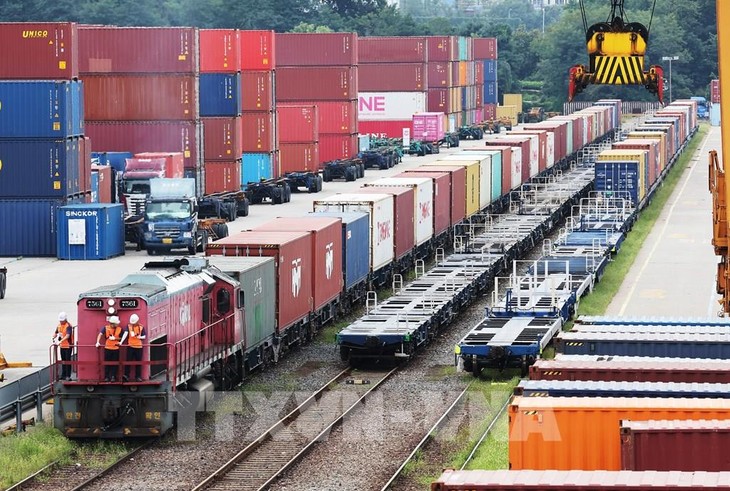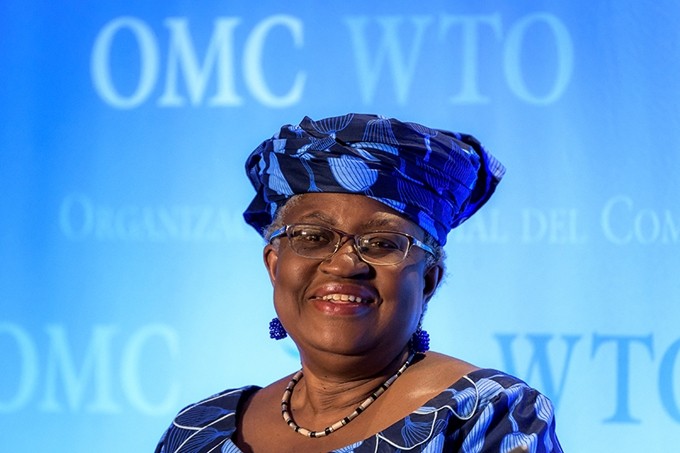(VOVWORLD) - Persistentinflation and high interest rates, slow recovery of many major economies, geopolitical instability, and rising public debt in many countries have caused a global trade recession this year. Economists say these difficulties will not end soon, but there are some hopeful signs for next year's global trade.
 A container terminal in Uiwang, Seoul, South Korea. (Photo: Yonhap/ VNA) A container terminal in Uiwang, Seoul, South Korea. (Photo: Yonhap/ VNA) |
In the report "Global Trade Update" published on December 11, the UN Conference on Trade and Development (UNCTAD) estimated that this year's global trade turnover will reach 30.7 trillion USD, down from last year's 32.2 trillion USD. Trade of goods will likely decrease nearly 2 trillion USD, 8%.
Unstable factors
UNCTAD said that the global trade decline is partly due to ineffective exports of developing economies in East Asia, and partly due to falling demand in developed countries. This year, the prices of many goods fell after a hike due to inflation in 2022. Falling commodity prices is a reason global trade in goods has declined, while trade in services is forecast to increase by 500 billion USD this year, an increase of 7%.
WTO Chief Economist Ralph Ossa said the global trade decline this year is mainly due to impacts in the first half of the year, when a series of negative factors appeared at the same time, including persistent inflation and high interest rates in the US and the EU, China’s less impressive recovery than forecast after the COVID-19 pandemic, and prolonged aftershocks of the Ukraine conflict.
In the second half of the year, those factors have improved. At the end of the year, the inflation rate in the Eurozone and the UK has dropped to the lowest levels in many months – 2.4% in the Eurozone and 3.9% in the UK. The US, the world's largest economy, has recorded an impressive GDP growth rate of 5.2% in the third quarter, and an inflation rate of 3.1% in November. China's economy also improved significantly in the last months of the year.
UNCTAD’s report noted that global trade has shown signs of recovery. Although the total transaction value decreased, the volume of trade goods increased 0.8%, reflecting a stable demand globally for imported goods.
UNCTAD said that countries with friendly relations tended to increase trade with each other, while less friendly countries reduced bilateral trade.
“While trade continues to strive in many ways, trade tensions are rising, and foresights of fragmentation are emerging. However, talks of deglobalization are still far from supported by evidence,” WTO chief economist Ralph Ossa said.
Uncertain prospect in the short term
UNCTAD said that risks related to geopolitical conflicts like Ukraine and Gaza, increased protectionist policies, and high public debt in many countries will continue to affect global trade flows, making the overall global trade picture uncertain in the short and medium term.
“We see the increase in trade restrictions that has been imposed by countries on one another. That started a year and a half and has exaggerated. And it’s likely lead to some negative impacts on trade flows,” IMF chief economist Pierre-Olivier Gourinchas said.
Sharing UNCTAD’s view of next year’s challenges, but the WTO forecast that global trade will increase, possibly 3.3% in goods volume.
WTO Chief Economist Ralph Ossa says a trade-in-goods increase is associated with the business cycle for machinery and durable consumer goods and areas that tend to recover quickly when economic growth stabilizes.
 WTO Director General Ngozi Okonjo-Iweala (Photo: AFP) WTO Director General Ngozi Okonjo-Iweala (Photo: AFP) |
WTO Director General Ngozi Okonjo-Iweala said global trade will "reshape" globalization in a more inclusive and sustainable direction, so that developing countries can truly benefit from trade and meet their climate change commitments.
Based on this year’s promising signs, some economists say the dominant trend in global trade is still promoting cooperation and signing free trade agreements, even between economies that previously had less connectivity.
This year the US and African countries have finalized 547 trade and investment agreements worth 14.2 billion USD, an increase of 67% compared to 2022. The South American Common Market has signed an FTA with Singapore and is conducting FTA negotiations with South Korea and Indonesia.